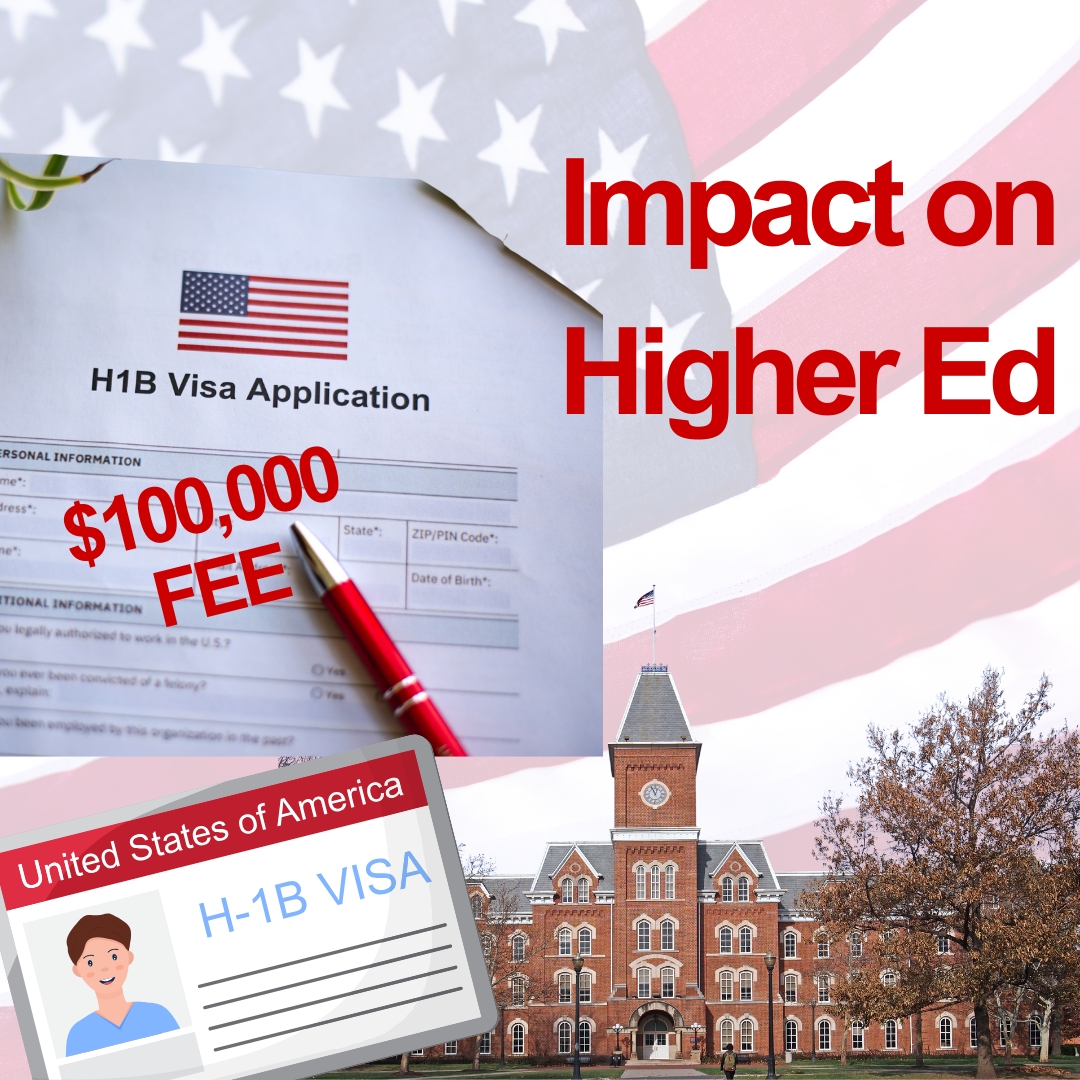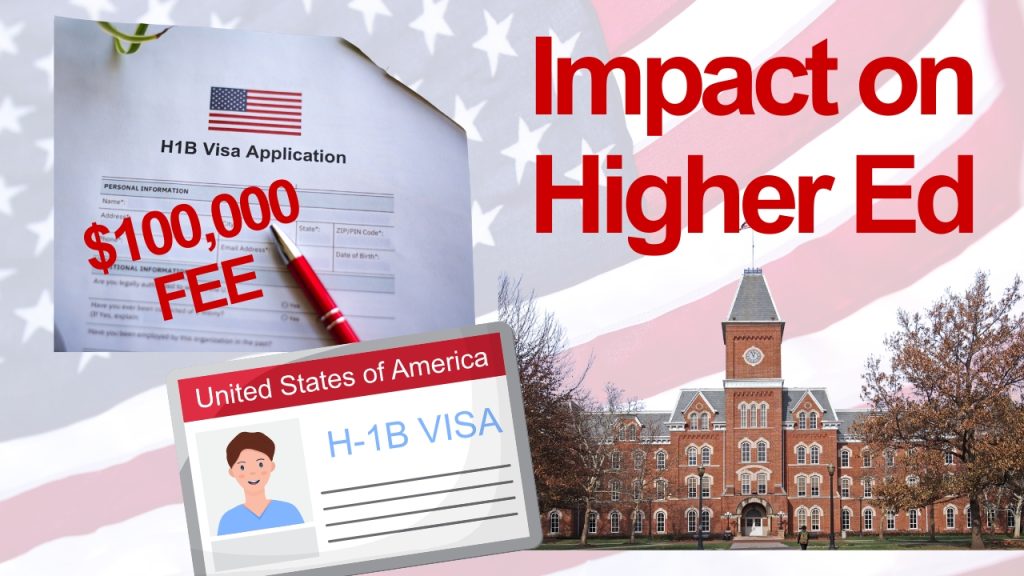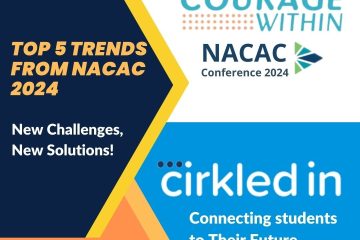How Does the New H1B Visa Fee Impact Higher Education?

If you missed or ignored the latest proclamation of a $100K fee on H1B visas from the White House on a Friday night, effective immediately that Sunday morning, you missed a very nausea-triggering roller coaster ride. The timing and scope of the proclamation set off panic worldwide and even impacted India’s stock market.
We, being from India—and India being the largest consumer of H1B visas—had the front-row seat to all the chaos unfolding.
Even if you have nothing to do with visas, it was mind-numbing to see the impact: visa holders along with their families disembarking from planes in the U.S., canceling planned trips to visit a sick family member, attend a wedding, or simply reunite with family after years.
Visa holders outside the U.S., panicking that they would have to pay $100K to re-enter after Sunday, paid up to $10K for a one-way ticket.
Now that the dust has settled, there’s a bit more clarity—but also a bigger fear:
What will come next? What could happen next?
This H1B visa proclamation created a lot of fear and havoc. Even with clarifications since the announcement, one fact remains: all new H1B visas will now carry a $100K fee.

H1Bs and Higher Ed: More Connected Than You Think
At first glance, some may shrug. “H1Bs? That’s about work visas. We only deal with F1 student visas.”
Think again!
Shrinking incoming pipeline (stating the obvious)
For decades, international students have come to the U.S. not just for a degree but with the long-term goal of working, building careers, and settling here. Families often invest their life savings in a child’s U.S. education with that dream in mind. Rarely does a student come just for education and then return home.
Even if some colleges don’t have international population, their neighboring campuses do.
This year, international students were already rattled by anti-immigrant policies and rhetoric and were feeling unwelcome. ICE raids on campuses, wrongful deportations of valid visa holders, and rising antisemitic rhetoric, raised risks and gave candidates pause.
And now, with their post-graduation work pathway (via H1B) jeopardized, due to hefty fees like $100K—or other future uncertainty—their educational investment looks increasingly risky.
The H1B fee announcement reinforced the anti-immigrant sentiments.
Even if exceptions are carved out for F1-to-H1B transitions, the perception of unpredictability is enough to deter students. The move has already sent shockwaves and skepticism across countries like India and China—the largest student sending countries and heaviest H1B users—now questioning whether the U.S. is still a reliable destination.
Students are even more wary. They don’t know what else may come with the “America First” initiative.
In fact, right now there is another proposal under consideration to make H1B visa lottery be wage based: higher salaries mean higher chances of approval. Fresh graduates—who naturally earn less—would be at a disadvantage and less likely to get their visa approved.
Here’s the key twist: Even colleges that don’t actively recruit international students will feel the impact. When neighboring or competing institutions lose international students, they will try to compensate domestically, shrinking the applicant pool for everyone. The ripple effect spreads across regions and institutions, making the enrollment landscape more competitive for all.
Early Indicators:
IN Q2 this year, many reports came out showing F-1 visas dropped 22% in May 2025 (12,689 fewer), J-1s fell 13%, and NAFSA projects an overall 15% decline this fall. Visa suspensions and new vetting rules are compounding delays. All of this happened was before the H1B visa fee proclamation.
Other Countries Are Seizing the Moment (stating the not-so-obvious)
While the U.S. tightens its doors, other nations are opening theirs wider—often with intentional strategies to recruit both students and skilled workers. Several countries started actively attracting international students and global talent with more welcoming measures, including clear post-graduation work opportunities, easier pathways to permanent residency, and supportive financial and academic policies.
India and Japan: Just this week, India and Japan signed a treaty to place 500,000 skilled Indian workers in Japan, create a win-win – giving Indian professionals another venue to go abroad while providing skill labor to Japan helping them address its population decline. India is also emphasizing “self-reliance” in education and employment while building new international partnerships.
China is aggressively courting global talent, launching a new K1 visa (open Oct 1, 2025) to allow foreign professionals to study and work in the country.
Hong Kong lifted its 50% cap on local enrollment to bring in more international students amid U.S. crackdowns on students on college campuses.
Germany isintroducing new initiatives and high-visibility social media campaigns to attract international students—including poaching U.S.-based researchers, increasing university funding for foreign talent, expanding post-study work opportunities, and even offering new travel deals. Germany is doubling down on its reputation for affordable, high-quality education, positioning itself as a leading alternative to the U.S.
Prior to all this, earlier this year, The EU committed €500M to research and innovation grants, to lure global scholars, filling the gap left by U.S. grant cuts on research and innovation.
These moves underscore a critical point: students and talent have choices. If the U.S. creates barriers, competitors will fill the vacuum.
A Double Whammy: Domestic Students Are Looking Abroad Too
The shocking part: with all this turbulence, the U.S. isn’t just losing international students—it’s losing domestic students too.
With initiatives from other countries making higher education more attractive, it’s bound to attract some US students as well.
According to an earlier report Applications from U.S. students to U.K. universities surged 14% for Fall ’25 (the highest since 2006), with deposits up 19%. Other countries’ affordability, clearer pathways to graduation, and global career options are proving attractive to American families questioning the value proposition of U.S. higher education.
Key Takeaways
- Global instability is now local risk. Visa policies, fees, and rhetoric abroad ripple directly into your admissions pipeline.
- Don’t over-rely on international students. Betting a class on international volume in this climate is risky.
- Even colleges without international programs are affected. When neighboring or competing institutions lose international students, they compensate domestically, shrinking the applicant pool for everyone.
- Diversify and double-down domestic recruitment: build micro-segment strategies, invest in in-state showcases, expand early opt-in pipelines, emphasize transfer and honors/accelerated programs.
- Monitor policy signals. Early awareness of shifts like wage-based H1Bs or new international student incentives abroad can inform your enrollment strategy before numbers show the impact.
International enrollment has always been cyclical, but this moment feels different. Policy-driven disruption is eroding trust, and competitors are moving fast to capture students who might once have chosen the U.S.
For institutions, the imperative is clear: don’t wait to adjust strategy until the numbers arrive. The time to adapt is now.



0 Comments